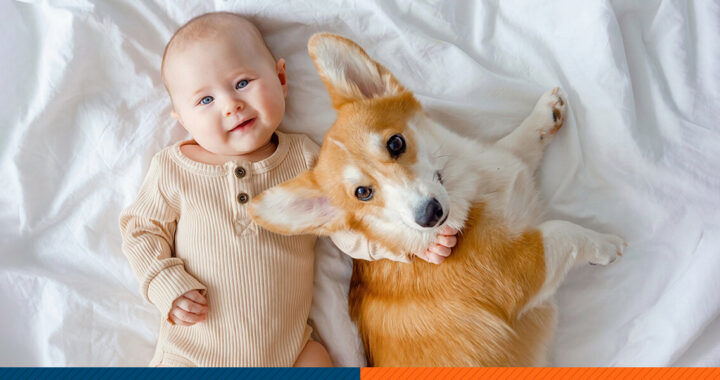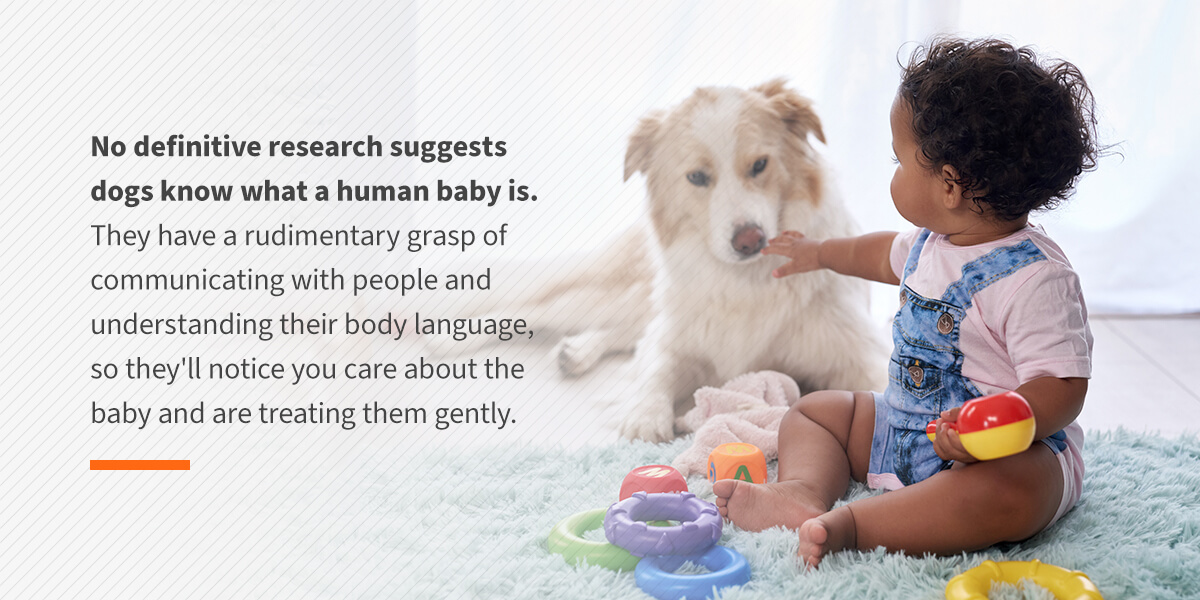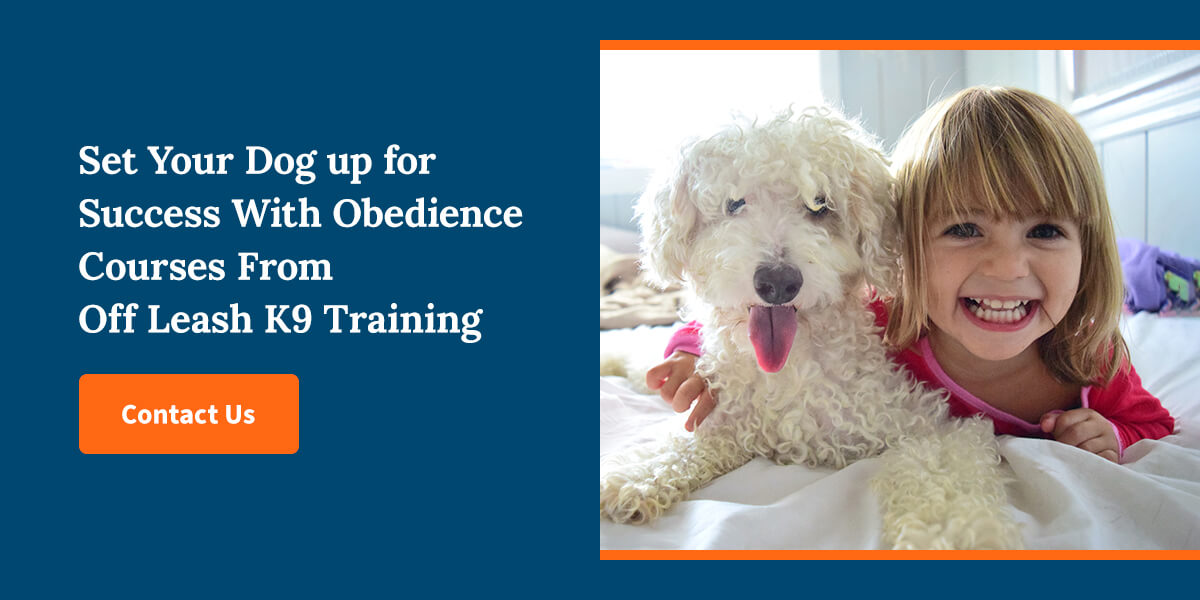Table of Contents
- What to Expect When You Bring Your Baby Home
- How to Introduce Your Dog to Your New Baby
- Tips and Tricks for a Smooth Introduction
- Set Your Dog up for Success With Obedience Courses From Off Leash K9 Training
The arrival of a new baby is exciting and nerve-wracking, especially if you have dogs. Having a dog in the family has many benefits, but worrying about how they will respond to a new baby is an added stress you don’t need when welcoming your bundle of joy.
The good news is that there is a way to introduce your dog to your baby the right way. A smooth introduction takes a little preparation and a lot of patience, but knowing what to expect goes a long way toward ensuring positive dog behavior with the new baby.
What to Expect When You Bring Your Baby Home
Dogs love routine and feeling comfortable in their home. Bringing a new baby into the mix can upset their routine and expose them to sounds and smells they’re unfamiliar with.
Your dog needs time to adjust to these changes. In many ways, their temperament will determine how they handle them. Your dog may be stressed by a new baby if they are already anxious. If they have a relaxed nature, a baby may not phase them.
Regardless of your dog’s temperament, you’ll have a better idea of what to expect if you take the time to prepare them, which is where training comes in. Any training you do with your dog before the baby benefits you all. For example, you may want to train your dog not to jump on the new furniture so that they do not accidentally harm your sleeping or resting baby. Your training should focus on the skills and commands your dog needs to understand when interacting with the baby. If you can master these, you’ll have more control over their first interaction.
Do Dogs Understand Human Babies?
No definitive research suggests dogs know what a human baby is. They have a rudimentary grasp of communicating with people and understanding their body language, so they’ll notice you care about the baby and are treating them gently. They can tell the difference between fully grown humans and small children, as they often display more protective behavior toward babies and toddlers.
How to Introduce Your Dog to Your New Baby
Thinking ahead will make introductions easier for you, your dog and your baby. Learn how to prepare your dog for a baby with the following steps:
1. Prepare Your Dog Ahead of Time
The most significant adjustment for your dog is the change in routine. Acclimating your dog to these changes as early as possible will help eliminate stress and ensure they don’t associate the changes with the baby. Consider playing your dog recordings of baby noises and allow them to smell all the new baby supplies as you bring them home.
Crate training provides your dog with their own space — off-limits to children — where they can go if they feel scared or uncertain. Training your dog to go to their crate will be especially vital as your baby grows and starts walking.
Throughout the preparation phase, ensure you address the following:
- Feeding: Provide a space where your dog can eat undisturbed. Dogs may correct puppies who come near their food, and you don’t want them directing that action toward your baby.
- Exercise: Dogs are easier to work with when they get adequate exercise. You may want to teach your dog to walk alongside your baby’s stroller so that they get the movement they need while you and your baby get some fresh air.
- Training: Training should be your top priority when preparing your dog for a new baby. Commands like “leave it,” “sit,” “stay,” and “go to your spot” will be invaluable in managing dog and baby interactions.
- Health: Before you bring your dog and your baby together, you want to ensure your dog is healthy and parasite free, so they can’t pass anything on to the baby.
- Crate training: Crate training takes advantage of your dog’s natural instinct to seek out a safe space when discomforted by their environment. When done correctly, your dog will associate the crate with something pleasant and will learn to love their safe space. Consult a professional for assistance here.
- Area blocking: Block off areas like the baby’s room in advance so your dog can adjust to the new rules.
2. Bring Your Baby Home
Have someone take your dog for a long walk before you bring your baby home. The introduction will go smoother if they are calm. When you get home, let your partner hold the baby while you enter the house and greet your dog. They will be happy to see you, so let them greet you properly — and expend some excess energy.
Once all the greetings are out of the way, have someone leash your dog and be ready with treats. Bring your baby into the house calmly — if you’re nervous, your dog will pick up on it. Greet your dog in a cheerful tone. Ensure your helper provides plenty of treats and praise when they stay calm.
Always reward your dog for calm behavior. If they are anxious or fearful, harsh corrections will compound those emotions. Be ready with treats and rewards whenever your dog is calm around the baby.
3. Introduce Your Dog to Your Baby
It’s up to you whether you introduce your dog and baby immediately. Remember, stay calm and positive throughout the experience and follow these simple steps:
- Pick a room your dog doesn’t see as their territory, and sit in a chair with the baby in your arms. Have someone bring your dog in on a leash.
- Once your dog’s body language is relaxed, give them the command to come to you.
- Allow your dog to sniff the baby gently, and praise them using a soft, positive tone.
- If you’re comfortable, give your dog more time to get to know your baby. If too much interaction makes you anxious, allow your dog and baby to interact in short bursts so that your emotions don’t stress your dog. Build their relationship slowly, allowing more supervised time as your dog adjusts.
Tips and Tricks for a Smooth Introduction
It all sounds straightforward, and it should be if you’ve done your homework. If you’re still nervous about the introduction, keep the following tips in mind:
- Train and train some more: If your dog can follow basic commands, introducing and letting them interact with your baby is much easier. Whether your dog has basic obedience training or not, consider enrolling them in a class, and let your instructor know your goal is a harmonious home.
- Buy plenty of dog toys: If your dog has plenty of toys, they will be less likely to steal from the baby.
- Teach your baby about your dog: As your baby grows, teach them about your dog’s safe space. Encourage your child not to touch your dog like you would teach them not to touch a hot stove. You can maintain this rule until your baby is old enough to interact with your dog positively.
- Prioritize supervision: Never leave your child and your dog together unsupervised. A simple miscommunication could end in disaster, so ensure someone responsible is always around to oversee their interactions.
- Allow the growl: Growling is your dog’s way of communicating that they’re uncomfortable with something. Punishing them for communicating will only remove the behavior, not the emotion behind it, so your dog might feel he has no choice but to nip without warning.
- Keep the diapers away: Your dog will eat diapers if they can find them, so always ensure they’re out of reach and disposed of properly.
- Wait until your dog is calm: If you notice that your dog seems overstimulated by the increase in activity, don’t let them smell the baby. Wait until they are calm and settled. You want to instill rules about being calm around the baby from the beginning.
Set Your Dog up for Success With Obedience Courses From Off Leash K9 Training
At Off Leash Canine Training Maryland, we believe in strengthening the bond between you and your dog through obedience training. We offer individual and group obedience training classes based on mutual understanding and building your dog’s confidence.
Whether introducing a new baby or wanting a happier, more obedient dog, our compassionate and knowledgeable trainers can help you. Please feel free to reach out to us today to learn more about letting the bond with your dog be off-leash!



